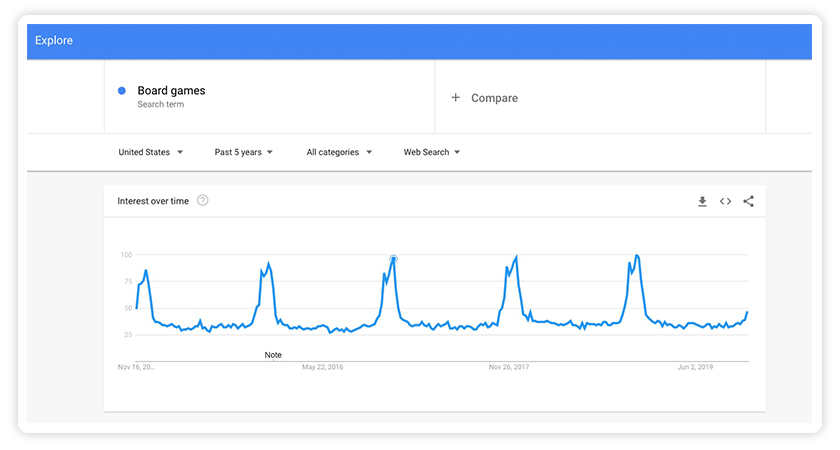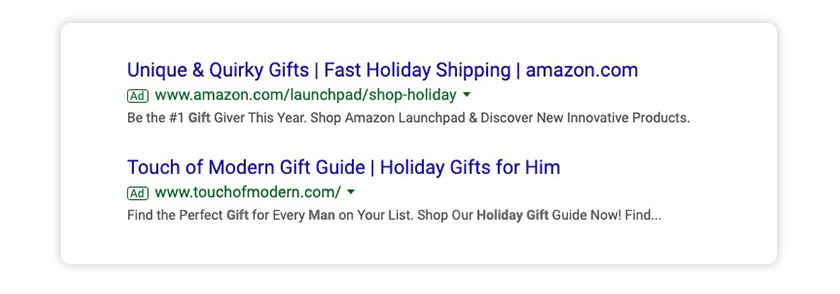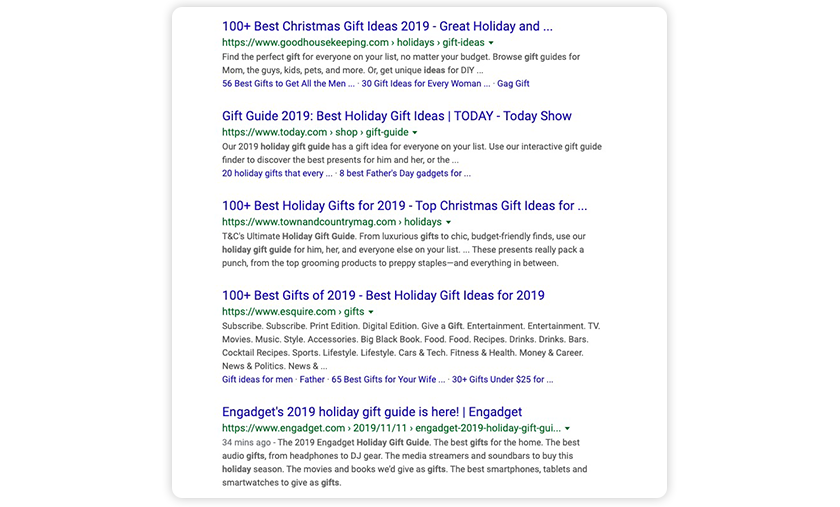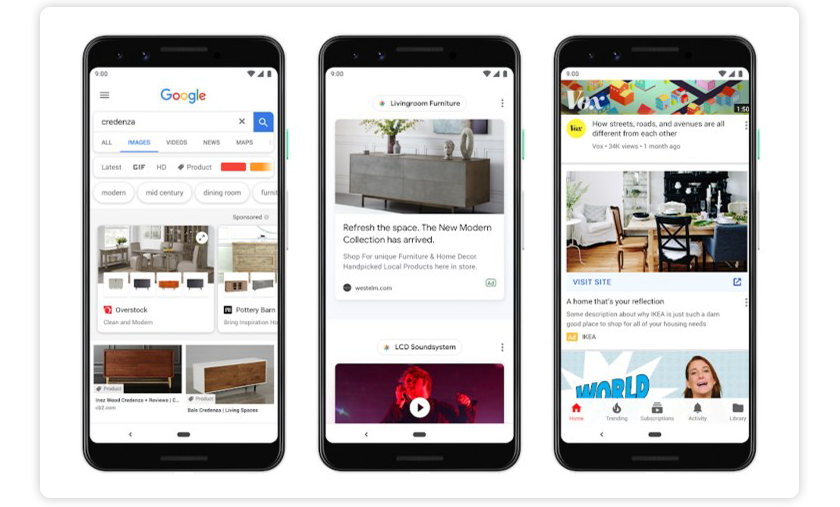Our media experts provide context and analyses on the latest search and social news in this monthly roundup.
Technology
Services
Resources

Holiday retail sales across crossed the $1 trillion mark in 2018, thanks in large part to the growth of eCommerce sales between Thanksgiving and Christmas. Paid search advertising offers huge opportunities to gain exposure and drive revenue during the holiday season, but competition is higher now than ever before.
Google has made some key changes to the search algorithm that will impact how your ads will be displayed when someone is searching for your target keywords, most notably with impression share bidding and query level targeting. There are numerous changes businesses have to make to their marketing campaigns to stay ahead of the competition during key holiday shopping weeks. These tactics are not yet mainstream in the PPC marketing fraternity, though, and only a few marketing managers know how to prioritize seasonal advertising tactics to maximize results.
Search engine advertisers who invest in the right collection of strategies can set themselves up to dominate the PPC landscape this holiday season. Here, we take a look at what you should do.
The holiday season represents a great opportunity to increase clicks, conversions, and sales. But you’re only going to see these benefits if you allocate enough budget to the holiday months.
How much budget you should save for November and December really depends on past performance. Look back on your campaigns from previous years and see how your impression share and clicks changed during key seasons.
Some questions to think about while creating your holiday strategy this year are:
Begin by calculating the revenue that your keywords generated in the past seasonal years. The best way to do this is by looking at your Google Ads Auction Insights report. This includes valuable metrics on how your ads performed compared to your competitors. Pay particular attention to:
Compare your performance on these metrics during November and December versus other months of the year. If your impression share, average position, and other metrics perform poorly during the holiday season, then you’re not allocating enough budget to keep up with competitor changes.
You also need to evaluate if you wasted any money on Google ads.
For eCommerce sellers, it’s easy to assume a larger portion of your annual sales will happen in the months before Christmas. Rather than creating a monthly budget to meet PPC sales goals, it’s better to consider how holiday shopping opportunities can impact annual sales overall, then budget accordingly.
Say, for example, you run a winter sports gear eCommerce business. You already know that search volume for your product keywords will be low from May through August. With this knowledge, you can decrease your monthly PPC budget for those months and reallocate it to November and December. This ensures you maximize your profit on holiday PPC campaigns while simultaneously meeting your annual sales goals overall.
If you don’t have a lot of historical data to evaluate your seasonal ad spending, then keyword search volume can help you understand targeting and bidding opportunities. Take your target keywords to Google Trends and see patterns in how search volume changes across the year. The keyword “board games” for example triples in search volume every December like clockwork:

Keywords like these offer more impression opportunities during the holidays versus other times of the year. It makes sense, then, to increase bids for these keywords to get a higher impression share and, in turn, clicks. At the same time, you might discover some product-related keyword phrases don’t show a dramatic increase in search volume or sales during the holiday season. You can redistribute ad spend by bidding less on these keywords during that time.
Even if you use automated bidding, you can still make manual bid adjustments to target more valuable keywords during the holiday shopping season. It’s vitally important, though, that you know when to gain control of your automated bidding strategy. Ultimately, it’s a machine, and your results from the machine will only be as effective as the information given to it.
Most advertisers don’t bother creating campaigns to target holiday-specific keywords every year. So this is a huge missed opportunity to reach a highly targeted audience that is ready to convert on search.
For instance, someone searching for “stocking stuffer ideas for toddlers” is definitely looking for Christmas gifts, and therefore is more likely to purchase the sponsored product suggestions:

It doesn’t require a significant time investment to create dedicated holiday PPC campaigns. Simply duplicate one of your current campaigns, replace the keyword lists, allocate more budget, and then wait for the increased conversions to roll in.

Now let’s look at another long-tail keyword - “christmas gift ideas for friends”. Consumers searching with this type of phrase know that they want to purchase something; they’re just not sure exactly what. Your ads are an opportunity to show them what you have on offer. Even if they don’t purchase the product you’re promoting, they can click through and convert on your website.
Whether you’re running shopping ads or a traditional search ad campaign, it’s important to include relevant information that relates to the very specific audience you’re targeting. For example:

People who look for holiday gift ideas online are often crunched for time. So, one of the above ads includes “Fast Holiday Shipping” in the headline to speak to this need. The second ad’s description says “Find the perfect gift for every man on your list.” This implies their business is a great place to find a gift for husbands, fathers, brothers, etc.
You should definitely base this year’s holiday PPC campaigns on last year’s performance, but don’t let that limit you from trying out new strategies altogether. The winter season is a great time to test out new channels, campaigns, and targeting strategies.
Set aside a certain portion of your PPC budget to try new initiatives. It could be a new targeting strategy or trying out a new feature in Google Ads. If you haven’t already, consider investing in automated bidding strategies. Instead of turning off your manual bidding campaigns, simply create an additional automated one. Then you can test and see which performs better.
Google’s Smart Bidding offers a variety of bidding strategies based on differing business goals. You can also use seasonality adjustments if you expect major changes in your conversion rates based on select events. Smart Bidding automatically considers predictable seasonal factors like Black Friday, Cyber Monday, etc.
Last year Google also introduced Smart Shopping campaigns for eCommerce advertisers. These combine Standard Shopping and display remarketing campaigns, helping advertisers win ad placement in prominent places across networks.
Arguably the biggest opportunity that eCommerce sellers should take advantage of this holiday season is Bing paid search. In November last year, Bing saw the highest retail growth from 5th November pre-Cyber Week. Here were their top categories for click share from 23rd - 27th November:

Bing PPC is less crowded than Google, making it easier to outbid your competition. The Bing audience is also willing to spend more on retail products than those on Google. So, consider investing in Bing this holiday season to get more reach and drive more sales.
Feed optimization is something that you should be working on all year round. But right before the holiday shopping season is an excellent time to start cleaning things up to ensure you give your conversion percentages a boost. This includes optimizing such elements as:
Regardless of whether you’ve already optimized all these things before, there’s always changes you can make that might improve click-through rates. Something as simple as changing the main product image can have a huge impact on performance. You can use Supplemental Feeds to test changes you make to different feed variations.
You should also go through and make sure all your fields are populated as missing data can cause Google to disapprove of products. Then you need to be certain that you’re not sending paid traffic to any “out of stock” product pages. You don’t want this happening during peak holiday shopping weeks.
Targeting audiences during the holiday season is a bit different than the rest of the year because people are primarily not shopping for themselves. In order to better target gift-givers, advertisers need to make changes to their marketing content and ads.
People often know what they want to buy for themselves, but are unsure about what others will like. Your marketing content should make efforts to convince readers that your products are something their loved ones would enjoy. Including social proof from other happy customers is a great way to do this. Solicit user-generated content (UGC) from your previous customers to highlight on your landing pages.

Creating top of the funnel content like gift guides can also help shoppers make decisions about the types of products they want to buy for their friends and family. This is a great way to supplement your paid search efforts with content for organic search engine results.
For your advertising copy, consider the target demographic in this case. People often do their holiday shopping online because they’re too busy to hit the physical stores or they’re looking for deals. Your ad copy should reflect this need. If you want your ads to perform well, promotions are simply a must. Use promotion extensions for search ads to highlight a sale, free shipping, free gift, etc.
Lastly, if your business offers gift cards and free shipping, make sure these options are clear on all your sales and product pages. Particularly in December, when shoppers are feeling rushed, they’re more likely to turn to gift cards rather than buying a product. You can even create special promotions highlighting your gift card offerings (e.g. buy a gift card valued $100 or more and get an additional $10 gift card free).
The type of ads you use can also have a huge impact on performance when targeting gift-givers. Showcase Shopping ads, for example, are a great option to help shoppers understand what kind of products are available related to a broad keyword search. Showcase Shopping ads allow you to group a selection of related products together to introduce audiences to your brand:

This is a great option for targeting first-time shoppers who want to learn more about a selection of products they’re interested in purchasing as a gift for someone else. This year, advertisers can also include video content as part of their Showcase Shopping ads, offering a new opportunity to stand out from competitors.
Audience targeting is another important area in which to make changes in order to better reach gift-givers with your advertising message. You may want to refocus efforts with your current audiences and/or add new audiences to improve your targeting.
Add new audiences
If you’ve created marketing content for your organic SEO efforts, you can build new audiences based on those who’ve interacted with it. For example, visitors who viewed a wishlist from your eCommerce store or people who viewed a gift guide.
Prepare remarketing lists
Remarketing lists are a great way to reach holiday shoppers later in the season. They may have visited your website in early November, but you can convince them to finally convert right before Christmas with a special offer.
Your remarketing lists can include repeat past purchasers, but what about the people who bought from you last November then never made a purchase again? These are much more likely to be gift-givers. Add them to your remarketing lists to convince them to shop with you again this holiday season.
Consider cross-channel marketing
Remarketing lists are also a great opportunity to drive conversions with cross-channel marketing. To explore the opportunities here, check out your Audience report in Google Analytics. This will show you how your audiences move through the funnel across marketing channels.

Do some experimentation here. You might find that re-targeting shoppers who clicked on your search ad with a relevant Facebook ad drives more conversions. Cross-channel marketing gives advertisers the opportunity to really drive their message home, convincing shoppers to buy.
As mentioned above, most people prefer to do holiday shopping online because they’re busy, it’s convenient, and they’re looking for deals. Shoppers have many options to make purchase decisions online. If you want them to choose your products, you need to make every effort to minimize barriers to purchase.
Offering free shipping is one of the best places to start. 9 out of 10 consumers say free shipping is their biggest incentive to shop online. Another important factor is the option for in-store pickup. Especially in a week or so before Christmas, many people are shopping online with the hopes of picking up a product in-store. These are both benefits that you can highlight on your product pages as well as in your shopping ads with merchant promotions:

There are many other changes that can make the online shopping experience easier and help reassure customers they’re making a good choice. You can guarantee shipping delivery before the holidays, for example. Or highlight your return policy, so they know they can get their money back if someone doesn’t like their gift. Streamlining your checkout process is also essential.
Businesses today have made a lot of efforts to improve mobile user experience, yet mobile cart abandonment is still 86% on average - much higher than on desktop. Lowering cart abandonment on mobile is particularly important during the holiday season, as last year the mobile share of digital commerce reached 40% on Thanksgiving.
In addition to improving mobile user experience on-site and during checkout, I would definitely suggest setting up a series of cart abandonment emails and retargeting ads to help capture these sales.
Online shopping during the holiday season will only continue to grow. Incentives like sales, same-day shipping and in-store pick up have made online the preferred shopping method for many before the holidays. So optimizing your holiday PPC campaigns to capture traffic isn’t just worthwhile, it’s mandatory for eCommerce success today. Prioritizing key months in your PPC strategy will ensure you stay ahead of the competition and maximize the value of holiday shopping to drive more sales every year.